MATH
106
PRACTICE FINAL
Please work out each of the given problems. Credit will be based on the steps that you show towards the final answer. Show your work.
PROBLEM 1
Evaluate the given integrals, derivatives and limits.
A)
(20 Points)
![]()
Solution
We integrate by parts with
u = tan-1(2x)
dv = dx
2
du =
dx v = x
1 +
4x2
The integral becomes
![]() u = 1 + 4x2 du =
8xdx
u = 1 + 4x2 du =
8xdx
= x tan-1(2x) - 1/4 ln|1 + 4x2| + C
B)
(20 Points) ![]()
Solution
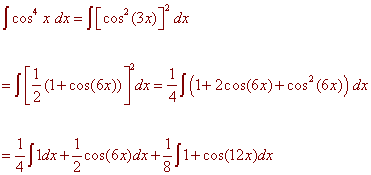

= 1/4 x + 1/12 sin(6x) + 1/8 x + 1/96 sin(12x) + C
C)
(20 Points)![]()
Solution
=
=
+
x3 +
9x
x(x2 +
9) x x2 + 9
A(x2 + 9) + (Bx +C)x = 18
x = 0: 9A =
18 A = 2
so
2x2 + 18 + Bx2 + Cx = 18
Equating coefficients
2 + B = 0 and C = 0
so
B = 0
Now integrate
![]() u = x2 + 9 du =
2x dx
u = x2 + 9 du =
2x dx
= 2ln|x| - ln|x2 + 9| + C
D)
(20 Points)![]()
![]()
Solution
This integral can be done with basic u-substitution
u = 4x2 + 25 du = 8xdx
The integral becomes
![]() =
3/4
u1/2 = 3/4 (4x2 + 25) + C
=
3/4
u1/2 = 3/4 (4x2 + 25) + C
E)
(20 Points) ![]()
Solution
Use integration by parts for this one.
u = ln x dv
= x3 + 4 dx
du = 1/x dx v = 1/4 x4
+ 4x
We have
![]()
= (ln x) (1/4 x3 + 4x) - 1/16 x4 - 4x + C
F)
(20 Points) ![]()
Solution
We can use trig substitution with
x = tan q
dx = sec2q
dq
![]()
Now integrate
= ln|sec q +tan q| + C
Now re-substitute to get
![]()
G)
(20 Points)
![]()
Solution

H)
(20 Points)
![]()
Solution
Use the definition of an improper integral and integrate by parts
u = x dv = e-xdx du = dx v = -e-x
 L'Hopital
L'Hopital
PROBLEM 2
Set up the integrals that solve the following problems. Sketch the appropriate diagram for each. Use a calculator to evaluate the integral.
A) (15 Points) Find the volume of solid that is formed by revolving the region bounded by y = x2 - 4x and y = 2x - 5 around the y-axis.
Solution
We draw a cross section perpendicular to the x-axis. This produces a cylinder.
We have
A = 2prh r = x h = (2x-5) - (x2 - 4x) = -x2+ 6x - 5
To
find the limits, we set the equations equal to each other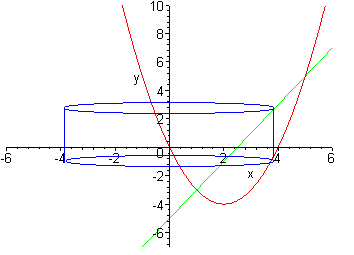
x2 - 4x = 2x - 5
or
x2 - 6x + 5 = 0
(x-5)(x-1) = 0
x = 1 or x = 5
The volume is

B) (15Points) Find the volume of the solid that is formed by revolving the region bounded by y = x2 + 1 and y = 5 around the line y = 10 .
Solution
We
draw a cross section perpendicular to the x-axis. We have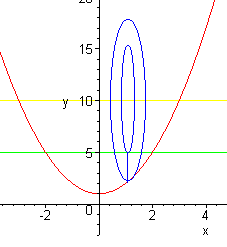
Set the equations equal to each other
x2 + 1 = 5 x = -2 or x = 2Now integrate
![]()
PROBLEM 3
(30 Points)
A force of 80 Newtons stretches a spring 70 centimeters on a mechanical device for driving fence posts. Find the work done in stretching the spring the required 70 centimeters.
Solution
Use Hook's law
80 = 70k k = 8/7Now the work is the integral of the force times the distance

PROBLEM 4 (11 Points Each)
In 1960 the world population reached 3 billion people and in 1999 the population reached 6 billion people.
-
Write down the differential equation that reflects that the rate of population growth is proportional to the population.
dP / dt = kP
-
Solve this differential equation and use your solution to predict the population in the year 2050.

ln P = k1t + C1
P = Cekt
C = 3
6 = 3e39k
k = 0.01777
Now plug in t = 90
P = 3e90(0.01777) = 14.84
-
It has been said, “It's the top of the ninth and humanity has been hitting nature hard. But we must always remember that nature bats last." In particular environmentalists have warned that the carrying capacity of the earth is 10 billion people. With this in mind it is better to use the model that the growth in population is proportional to the product of the population and 10 billion minus the population. Write down a differential equation that reflects this statement.
Solution
dP/dt = kP(10 - P)
-
Solve this differential equation and use your solution to predict the population in the year 2050.
Solution
 = k1t + C1
= k1t + C1
1/10 ln P - 1/10 ln10 - P = k1t + C1
ln P - ln(10 - P) = kt + C
ln 3 - ln(10 - 3) = k(0) + C
C = ln(7/3) = 0.8473
ln 6 - ln(10 - 6) = k(39) + 0.8473
k = -0.1133
Plug in 90 for t and find P. P is about 10. So the population will just about reach its carrying capacity of ten billion people.
PROBLEM 5 (31 Points) Let f(x) = x3 + x + 4
-
Prove that f(x) has an inverse function.
Solution
We use the theorem that tell us that if f(x) is monotonic then the inverse exists. We have
f '(x) = 3x2 + 1
Which is always positive, hence f(x) is monotonically increasing. Therefore f has an inverse.
-
Let g(x) be the inverse of f(x). Find g'(4) .
Solution
We use the formula
1
g '(4) =
f '(g(4))
We find g(4) by setting f(x) equal to 4:
4 = x3 + x + 4
x3 + x = 0 x(x2 + 1) = 0
Hence x = 0. Now calculate
f '(0) = 3(0)2 + 1 = 1
Finally
1
g '(4) =
1
PROBLEM
6
Please
answer the following true or false. If
true, provide an explanation. If
false provide an explanation or counter-example.
A.
(15 Points) If f(x)
is a continuous positive function then the surface area generated by revolving
the curve y = f(x)
for
0 < x < 1
about the x-axis is equal to the
surface area generated by revolving the curve y
= f(x) + 1 for0 < x < 1
about the x-axis
False, when using frostrums, the radius for the first case is f(x) and the radius for the second case is one more than that.
B. (15 Points) An aquarium has two exhibits each with vertical windows of the same area such that the bottoms are at the same depth and the tops are at the same depth. Then even though the shapes of the two windows may be different, the fluid forces exerted on the windows are equal.
Solution
False, if the first window has most of its area at the top part of the window, it will have a smaller fluid force exerted on it then a window with most of the area at the bottom part.
Questions, Comments and Suggestions: Email: greenl@ltcc.edu